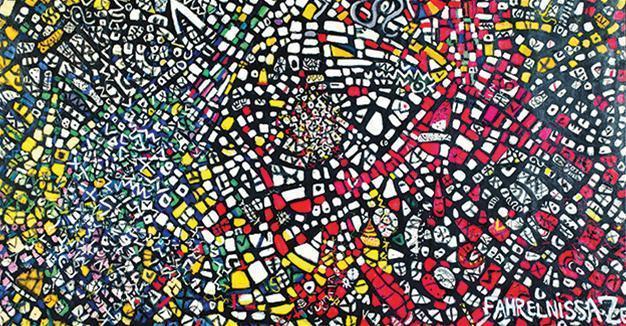Tate Modern presents Zeid
ISTANBUL
 Tate Modern is presenting the United Kingdom’s first retrospective of Fahrelnissa Zeid, a pioneering artist best-known for her large-scale colorful canvases that fused European approaches to abstract art with Byzantine, Islamic and Persian influences.
Tate Modern is presenting the United Kingdom’s first retrospective of Fahrelnissa Zeid, a pioneering artist best-known for her large-scale colorful canvases that fused European approaches to abstract art with Byzantine, Islamic and Persian influences.This major exhibition, which opened on June 13, brings together paintings, drawings and sculptures spanning over 40 years from expressionist works made in Istanbul in the early 1940s, to immersive abstract canvases exhibited in London, Paris and New York in the 1950s and 1960s, finishing with her return to portraiture later in life.
Zeid was one of the first women to receive formal training as an artist in Istanbul, continuing her studies in Paris in the late 1920s. The show reveals her breakthrough moment in the early 1940s, when she championed experimental approaches to painting and exhibited with the avant-garde D-Group in Turkey.
The exhibition looks at how Zeid’s work from this period, such as the tapestry-like “Third-Class Passengers” (1943), demonstrate her affinities with and divergence from international art movements, blending European painting traditions with Oriental themes.
Several works from her first solo exhibitions, held in her own apartment in Istanbul in the mid-1940s, are reunited, including “Three Ways of Living (War)” (1943) and “Three Moments in a Day and a Life” (1944).
In 1945, Zeid and her husband, Prince Zeid al-Hussein of the Hashemite royal family, moved to the U.K. where he had been posted as Iraqi ambassador. Splitting her time between London and Paris, Zeid’s exhibitions were well received by critics and artists alike, cementing her position as one of the great female artists working at the time.
Two works from this period signal her turning point from figuration to abstraction: “Fight Against Abstraction” (1947), which shows the confident use of strong black lines that became a motif throughout her career and “Resolved Problems” (1948), with its vibrant colors and patterns that looked towards op and kinetic art. Key pieces from her 1954 show at the ICA in London are also featured, such as “My Hell” (1951), “The Octopus of Triton” (1953) and “Sargasso Sea” (1953), representing the artist at the height of her career as well as the captivating East-West dialogue in her work.
When the Hashemite royal family was assassinated in a military coup in Iraq in 1958, Zeid and her husband were forced to vacate the embassy and her studio in London. They found a modest flat and for the first time in her life, Zeid had to learn to cook.
Although she had previously painted on stones, time spent in the kitchen inspired her to do the same on turkey and chicken bones, which she later cast in polyester resin panels evocative of stained glass windows – a selection of which are featured in the exhibition.
In response to the coup, Zeid also made a return to figurative painting. For the last 20 years of her career she painted portraits of her friends and family with exaggerated features that recall the anti-naturalistic character of Byzantine art.
Zeid spent the last years of her life in Amman, Jordan, where she transformed her home into an informal art school and surrounded herself with a cosmopolitan group of female students.
She died in 1991, aged 89, having exhibited across Europe, the United States and the Middle East. She left behind a remarkable visual legacy of her extraordinary life as well as a significant contribution to the global history of modernism.
The exhibition is curated by Kerryn Greenberg, a curator of the International Art, and Vassilis Oikonomopoulos.
The exhibition, which will continue through Oct. 8 at Tate Modern, will also travel to Deutsche Bank KunstHalle in Berlin in November 2017.
















